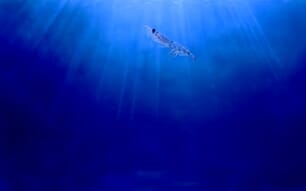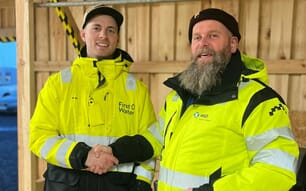Identity
Perna canaliculus (Gmelin, 1791)
FAO Names: En - New Zealand mussel, Fr - Moule de Nouvelle-Zélande, Es - Mejillón de Nueva Zelandia
Biological features

Shell up to 260 mm long, 110 mm wide and 90 mm deep. More elongated and curved than Mytilus edulis. Shell colour of juveniles bright green, wild adults often dark purple to black; farmed adults green to yellow-brown, often with brown stripes radiating from the umbo or brown spots. Inside of shell milky white and slightly iridescent. All specimens possess distinctive green lip along inside margin of shell. Individuals either male or female throughout their life. Immature and mature male gonads creamy white; mature female gonads vivid orange to pink. Foot golden-brown and can stretch to 30 mm in a 100 mm long animal. The most closely related species is Perna perna, which is native to South America and Africa, and closely resembles P. canaliculus.
Profile
Historical background
The New Zealand mussel (Perna canaliculus), also referred to as the Greenshell® Mussel, has been harvested for human consumption since the beginning of human habitation in New Zealand. Dredging wild populations from soft sediments was the first commercial activity. Most were processed into a powder that was marketed as an anti-inflammatory remedy. The first farming trials were done in the mid-1960s, using pontoons similar to those used in Galicia (Spain). The first commercial harvest was in 1971 (7 tonnes). Japanese-style longline technology was introduced in the mid-1970s. Since then this technology has been refined and adapted for mechanized farm management and high cost-effectiveness in sheltered near-shore areas. In 2003, a research and development project was started with the aim of adapting the longline technology to exposed off-shore waters. Since 2000, the Cawthron Institute has been carrying out a selective breeding program. The benefits of this long-term project will be taken up by commercial hatcheries that will be established from 2005 onwards.
Main producer countries
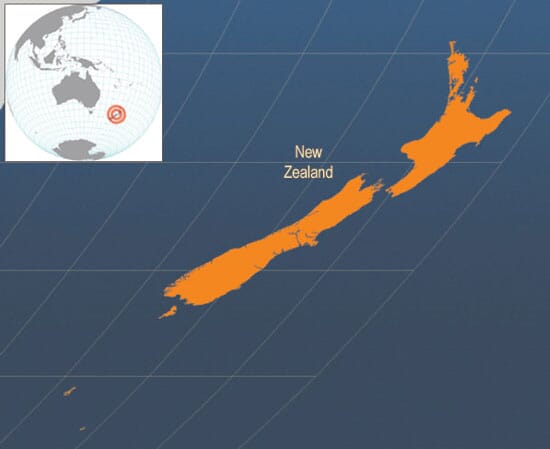
Habitat and biology
Perna canaliculus is endemic to New Zealand. It occurs throughout the country but it is more common in the warmer North. It prefers moderately exposed situations and full salinity. Mussel farming is restricted to areas that are suitable with respect to its biology (high subtidal) and the sea conditions (sheltered in-shore areas). The major growing areas are Coromandel, Marlborough Sounds, and Stewart Island. In New Zealand's moderate climate, P. canaliculus grows to 90-100 mm (normal harvest size) in 18-24 months.
Production
Production cycle
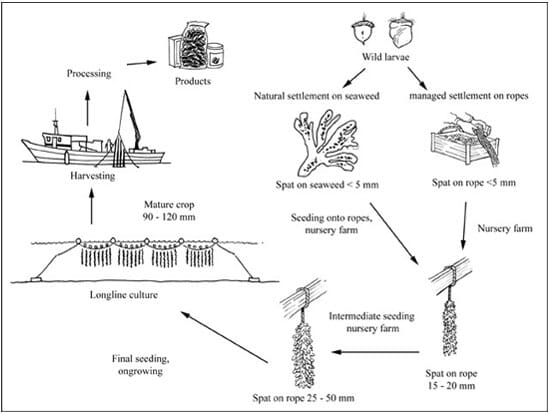
Production systems
Seed supply
The first stage involves the procurement of spat (seed) for ongrowing on the culture ropes. Spat comes from two sources:
- Farmers suspend spat catching lines in areas that are known to produce high numbers of planktonic larvae ready to settle. A spat settlement monitoring programme carried out by the New Zealand Marine Farmers Association and personal experience provide a guideline, but results can be variable. Spat catching on ropes is costly and provides a small portion of the total spat required, but this spat tends to be of high quality.
- A natural phenomenon which occurs on the North West Coast of the North Island of New Zealand provides the major source of spat. At irregular times throughout the year considerable quantities of newly settled spat attached to seaweed are washed up on the beaches in the region of Kaitaia. The seaweed is collected by local people and then carefully and quickly transported to growers in other parts of the country.
Currently, the industry is entirely based on the use of wild spat. However, the technology for small scale hatchery seed production has been established in New Zealand and commercial-scale hatchery seed production is expected within 5 years.
Nursery
Upon arrival at the farm, the spat is resettled onto nursery lines. This is done by holding the seaweed against the nursery rope with a light continuous tubular cotton stocking. The seed mussels attach to the rope within hours. The stocking and seaweed biodegrade within weeks. A seeding density of 1000 to 5000 spat per metre is optimal. It is important to minimise stresses such as heat and dehydration on the spat throughout harvesting, transport and reseeding. Predation is a limiting factor. Small mussels are vulnerable to predation by various fish species (snapper, spotty, leather jacket): nursery lines are kept in areas with low fish abundance, and recreational fishers are welcomed by the growers to tie up to the farm and fish from it.
Fast and highly manoeuvrable vessels are used for nursery and longline seeding and carrying out of maintenance and inspection chores. Special vessels are used for the initial anchoring and setting up of longlines together with the task of underwater inspections and replacements as necessary.
Ongrowing techniques
The siting of mussel farms is governed by several factors. Clean unpolluted water is the most essential consideration, followed by the need to site farms in areas of relatively calm sea conditions and out of the effect of ocean swells. Care has to be taken not to site farms where they will interfere with or impede the passage of vessels of all types. Water depth is also important, with most farms being in depths of 5-30 m.
Mussel farming in New Zealand is carried out on longlines. A longline is typically 110 m long and consists of two strong parallel ropes separated by plastic floats that are about 1.2 m long. The longlines are anchored at both ends on the seafloor with concrete or screw anchors. The cultivation rope hangs in loops of 5-10 m depth from the longline. A typical cultivation rope is 3 500 m long and carries 40 tonnes of mussels at harvest. As the weight of the crop increases during the growth of the mussels, more floats are tied between the longline 'backbone'. The average area is between 3 and 5 ha, although farms may vary from 1 to 20 or more hectares. The shape of the boundary is determined by the geography of the area and water depth. Much bigger farms are currently planned. Where necessary, navigational channels are provided between farms to give ready access to and from shore.
After 3-6 months growth on the nursery rope, the juveniles (10-30 mm) are stripped from the ropes and seeded at a rate of 150-200/m onto a thicker rope, using a larger diameter cotton stocking to once again secure them until they attach to the rope of their own accord. This rope is then fixed in loops to the surface longline where it will remain until harvest time. As before, the cotton stocking is biodegraded after the mussels have firmly attached to the growing rope.
The duration of the growing cycle varies from site to site and depends on the number of mussels per metre of rope, food concentration (plankton, detritus), temperature, and water movement. It takes 12-18 months from final seeding to achieving 90-120 mm mussels. Farmed mussels reach market size about twice as fast as wild mussels growing in close proximity, and they retain the green shell colour. Low-intensity monitoring of crop and installations is required during the ongrowing period.
The vessels used for New Zealand mussel farming today are a far cry from those used in the days of development in the 1960s and 1970s. The first boats were small launches or fishing vessels which were used for every phase of the job, from spat collecting through to harvesting and delivery. The use of these small boats meant that the work was very labour-intensive, physically demanding and time-consuming. The rapid increase in production over the past three decades, coupled with an obvious need for innovation, has seen the development of a new style of fleet in the mussel industry. Today's vessels are highly specialised.
Harvesting techniques
Harvesting, which was originally carried out by hand and then largely by towed barges, is now done by specially designed large harvesting vessels. These are fitted with a complex array of efficient purpose-designed labour-saving equipment. A series of in-line mini-cranes progressively raise the heavy mussel-laden longline to where the hydraulic stripper pares the mussels from the culture rope. The rope is automatically fed into a container bag for cleaning ashore and later re-use. The mussels are stripped from the ropes and then pass into a revolving drum. This drum, with its high pressure water jets and revolving action, both cleans and de-clumps the mussels. They are then deposited onto moving belts for sorting. Broken shells are discarded.
The clean live mussels are packed into specially designed one tonNE transporting bags or 25 kg wholesale sacks for the local market. The vessel's on-board crane is used to stack the full sacks along the deck as they are progressively filled. These self-contained harvesting units employ a crew of three to six people depending on size. The larger vessels can harvest >100 tonnes of washed, separated, ready-for-processing mussels in a day's work. As they are self-propelled, it never takes long from the farm site to delivery at the nearest unloading point. These specialist vessels are all of shallow draught so that the state of the tide will not unnecessarily delay access to wharves or slow the delivery process. The combined use of shore facilities and the vessel's own crane ensures that the unloading process is swift.
The size of the mussels largely determines the harvest time. Different markets demand specific sizes, or product forms, or both, and accordingly size is often an important consideration when deciding when to harvest any particular crop. Mussels destined for the half-shell markets are generally harvested earlier than those required for use as whole individually quick frozen (IQF) mussel meat.
Because there is no set season when mussels might spawn, care is taken to harvest them at their peak condition. Before harvesting a line, samples are inspected to ensure that the mussels are fat and succulent and not thin from having spawned in the days preceding harvest. Contract harvesters are experienced in making these judgements and inform growers accordingly. The industry is careful to ensure that only mussels in top condition enter the processing chain and go on to the marketplace, whether it is domestic or international.
Harvesting is carefully synchronised with factory production schedules in order to maintain top quality and comply with hygiene standards. Even though the mussels can stay alive for several days out of water, the time from harvesting to processing is kept to a few hours. The transport chain from harvesting on the farm through to the factory is carefully organised so that processing capacity matches the harvesting rate on a day-to-day basis. Mussels are harvested into 1 tonne synthetic bags on board the harvesting vessels. These specially designed bags allow the mussels to breathe during transport and provide a very efficient means of handling. All mussels must be alive before entering the processing phase.
Handling and processing
New Zealand mussels are processed in state-of-the-art high-tech factories that operate under very strict hygiene and quality control regimes that are determined by both New Zealand Government regulations and international food processing standards. Regular inspections are carried out by Government inspectors, and each factory runs its quality programme.
The mussels are processed into many product forms (see Market and Trade section) but, regardless of the final form, the flow through the processing chain is very rapid. The bulk of production takes little more than thirty minutes from the beginning of the cycle until final packaging. All plants use extremely quick-freezing spiral freezers and most utilise automatic weighing and packaging equipment.
Production costs
Because labour is a major portion of the production cost, the industry is highly mechanised. Other major costs are materials and boats. Compliance (food safety, resource consent) requires an increasing budget. Spat is not a major cost.
Diseases and control measures
| DISEASE | AGENT | TYPE | SYNDROME | MEASURES |
|---|---|---|---|---|
| Not named | Not known | Virus | Epithelium of digestive tubules sloughs off into the lumen | None stated |
| Not named | Herpes-like virus | Virus | Occasional spat mortality | |
| Vibriosis | Not known | Bacteria | Not stated in Perna canaliculus but in larvae & spat of other mussel species may include bacterial attachment to external shell surface along the peripheral valvular margin, followed by epithelial necrosis; if systemic can result in death | |
| Gill ciliate infections | Not defined | Protozoans | Rarely seen; no pathological changes reported; ubiquitous; even large numbers elicit no obvious host-response and attachment to the gill epithelia appears to be superficial | |
| Parasitic infections | Lichomolgus uncus; Pseudomyicola spinosus | Copepods | No damage to epithelia reported | |
| Haemocytosis | Unknown | Unknown | Non-specific response; may be caused by absorption of unspawned gametes |
Rainfall monitoring
Because of the high water quality in the growing areas, New Zealand mussels do not require depuration between harvest and processing. However, the risk of occasional bacterial contamination needs careful management. Rainfall affects the bacteriological shellfish quality by carrying microbes from the land (mainly animal faeces) into the growing waters. Mussels may ingest these bacteria and concentrate them in their digestive system.
The shellfish quality programme prevents the harvest of mussels that may pose a health risk to consumers. Strict rules apply to the harvesting of mussels during and after rainfall. Extensive tests have been carried out in the catchments of all mussel farming areas, and the effect of rainfall on specific sites has been scientifically measured. For all farm sites, the level of rainfall at which harvesting is prohibited and the length of time after rain before harvesting can re-commence have been determined. Regular ongoing monitoring is carried out by independent authorities to specifications and standards set by the US Food and Drug Administration (USFDA). Rain gauges strategically placed in the various catchments provide electronically transmitted information to harvesters as to when harvesting may or may not proceed.
Biotoxin monitoring
All New Zealand shellfish-producing waters are regularly monitored for the presence of algal blooms. These naturally occurring marine phenomena have been observed worldwide. They provide food for the mussels and other filter-feeding shellfish. Some algal blooms produce biotoxins that can sometimes accumulate in the shellfish. Generally these toxins are not harmful to the shellfish and their presence is transient. However, certain biotoxins can be harmful to humans, and strict regulations are observed to protect the shellfish consumer.When toxic blooms or shellfish are detected, the harvesting of all shellfish, both farmed and wild, is suspended until continuing tests prove negative. These tests, like the rainfall monitoring regime, are carried out according to international standards and are well accepted and approved by all of New Zealand's export destinations.
Statistics
Production statistics
Global aquaculture production of Perna canaliculus
(FAO Fishery Statistic)
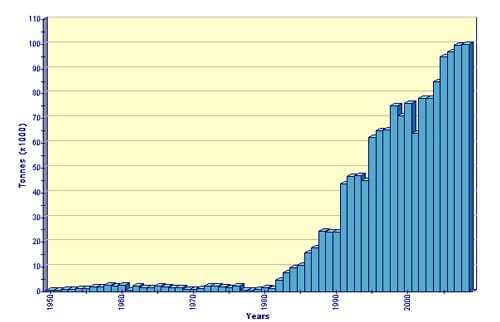
All production of New Zealand mussels occurs in New Zealand itself. Production first rose above 70 000 tonnes/yr in 1998 and has remained above that level until now (2002). According to FAO data, the 2002 harvest was worth USD 85.8 million. In 2000 there were 605 farms with an area of sea totalling 2850 ha (the sum total of all of the marine farming areas used for mussel longlines).
Market and trade
The domestic market takes a small portion of the product. New Zealand mussels are currently exported to about 60 countries, the major importers being Japan, Australia, USA, and Europe. In 1988 exports totalled NZD 24 million (FOB). By 2000 that figure had risen to NZD 170 million (FOB). This represents a growth of over 708 percent for the 12 year period. The weight of processed exports in the year 2000 amounted to 28 068 994 kg, representing an export return of NZD 59 649 for each hectare used for mussel production. In 2002, export earnings totalled USD 123.5 million.
Depending on the specific market destination, New Zealand mussels are sold on the half shell, whole out of shell, live in shell, frozen in shell, or individually quick frozen (IQF). Those frozen in the half shell make up over 70 percent of total export sales, making New Zealand the world's leading exporter of half-shell mussels. A number of factories also specialise in a variety of other lines, such as smoked mussel meat, mussel chowder, crumbed, coated and stuffed mussels, marinated, powder, and vacuum packed. Whole live mussels are popular with chefs and domestic users alike, as they can prepare them to suit their own recipes and serving preferences.
New Zealand mussels are truly versatile, and there is a product form to suit almost every taste or serving style. Processed mussels have a longer shelf life than many seafood products and, provided the packer's recommendations are adhered to, they can be enjoyed as a year-round delicacy.
Status and trends
Research
A considerable amount of research has taken place in the mussel industry and continues unabated as growers and processors strive to enhance every aspect of production and environmental management. Initial research was directed at developing systems that best suit New Zealand conditions. After the establishment of the longline system, research took on more complex and specific targets involving both laboratory work and field trials. A selective breeding programme is underway, and the technology for small scale hatchery seed production has been established. Commercial-scale hatchery seed production and off-shore farming are expected within five years.
Research is carried out by a number of government agencies, universities and private research organisations. This work is regarded as being amongst the most progressive and advanced of its kind in the world and is held in high regard globally. As an example, the New Zealand bio-toxin monitoring program is considered to be the most advanced of its type in the world.
Industry development prospective
The increase in production has slowed down due to a moratorium on the granting of new resource consents while the regulatory framework for aquaculture is being revised. However, the industry is expected to treble its earnings by 2020. This growth will come from increased farming area, increased production rates, increased efficiencies, and higher-value products.
Market prospective
The industry is developing new products that will distinguish Perna canaliculus from other mussel species in the international market. Selective breeding will be a major vehicle for achieving and maintaining uniqueness and entering new markets. The largest processor and marketer has obtained organic certification for its product, and other companies are likely to follow this move.
Main issues
The major current issue in New Zealand is the regulatory framework within which the industry operates. Property rights to areas suitable for aquaculture need to be clarified so that mussel farmers can have a guaranteed tenure that is long enough to warrant investment. The process of granting marine farming licenses needs to be rationalized.
Responsible aquaculture practices
All of the environmental studies carried out to date give New Zealand mussel farming a clean bill of health. Since the inception of mussel farming in the late 1960s there has been minimal ecological imbalance observed upon or near established marine farm sites. The fact that most farms are sited in areas where they occur naturally has some bearing on this outcome.
The very small uptake of food organisms passing through the farms, as a percentage of the whole, has no adverse effect on the food chain and therefore does not disadvantage other marine life living in the vicinity. Indeed, by providing a host environment, the loaded longlines actually benefit many other marine creatures. In many sites this provides a flow-on benefit for recreational anglers.
Perhaps the most positive aspect of this type of farming in the environmental sense is the fact that no harmful additives are used. The only artificial or man-made components are the inert floats, ropes and anchors that provide a support for the mussels while they grow. There is no use whatsoever of fertilisers, herbicides or pesticides; in that respect mussel farming is even cleaner and greener than organic gardening.
In terms of the shared use of the environment, the regulations governing the siting of marine farms, and the longline arrangement within them, ensure that they do not dominate the landscape. Ample provision is made in all areas to provide ready access for all other marine users. The statutory placement of lights and navigational aids make navigation easier, especially at night.
The only significant impact on the environment is of a visual nature, in the form of the floats that support the longlines. In order to keep the visual impact to a minimum the industry code of practice calls for growers to avoid untidy lines, upended buoys and shoreline detritus. In view of the overall benefits provided by the industry, the visual impact of longline floats is a minimal factor to accept.
The mussel industry is vitally dependent on a high quality marine environment and is extremely careful in all of its operations to maintain standards and, where possible, to seek improvements.
New Zealand, unlike many other countries that practise marine farming, has very little heavy industry and few sources of pollution. Being far from neighbouring countries means that it is not beset with the problems of pollution manufactured by others, such as acid rain and waste carried along communal waterways.
Although New Zealand has a low population base, mussel farms are sited well away from cities and centres of population. In order to ensure that coastal water quality is maintained, the shellfish industry works closely with land users to avoid adverse effects on the marine environment from land use. The vessel operators are bound by the anti-pollution regulations that apply to all marine users in New Zealand.
In all of its land-based operations the New Zealand mussel industry is conscious of its obligation to minimise or eliminate pollution. The industry currently funds and promotes research to provide environmentally sustainable waste management practices and its environmental policy stresses the "5R" principles of waste management – reduction, re-use, recycling, recovery and residual management.
August 2010



